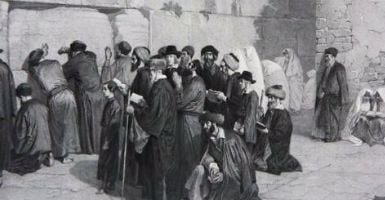The initial essay in this series discussed the Machlokes between the Rosh and Rambam regarding the application of the principle of “Hitiru Sofan miShum Techilasan” to soldiers who leave the Techum to save lives. The Rosh holds that if the Jewish people overpower their enemies, their soldiers must remain within 2000 Amos, though they are permitted to carry their weapons with them. If the enemies prevail, the Jewish soldiers may go any distance to find a fortified location and may certainly carry their weapons with them.
The Rosh’s conclusions are disputed by the Rambam in Hilchos Shabbos (27:17):
All who leave to save Jewish lives from idolaters, a [flooding] river, or a building collapse have 2000 Amos in each direction from the place where they performed the rescue. But if the idolaters were in power and they were afraid to remain [there], they may return to their original location with their weapons on Shabbos.
The Rambam implies that they may only carry their weapons with them in one case – if they were defeated by the enemy. His logic appears to be that if they were victorious, there is no reason to carry their weapons. Only when they were defeated in battle are the soldiers permitted to return with their weapons since they remain in danger from further attacks.
However, in Perek Beis of Hilchos Shabbos (Halacha 23), the Rambam implies otherwise:
Non-Jews who laid siege to a Jewish city… If they came to kill, or for war, or they simply besieged the city, the Jews may go out against them with weapons and desecrate Shabbos… When they have saved their brethren they may return to their original location with their weapons on Shabbos so that it will not be a stumbling block for them in the future.
These two Halachos appear to contradict each other. In Perek 27, the Rambam rules explicitly that the soldiers may only return home when the non-Jews prevail (due to the danger of remaining in an unfortified area, as explained by the Gemara). However, in Perek 2 he seems to place no such restriction; even after the Jewish soldiers “saved their brethren”, meaning, they prevailed and defeated their enemies, they may nevertheless return home. The Rambam even offers a reason, namely, “so that it will not be a stumbling block for them in the future”, or, in other words, Hitiru Sofan miShum Techilasan.
Aside from the contradiction in his rulings, the Rambam’s reasoning is very perplexing. The Gemara states explicitly that a Melacha d’Oraisa may only be performed in a situation of Sakana. The Heter of Hitiru Sofan only permits Melachos d’Rabbanan, and even then, only in limited scope (walking further than 2000 Amos is an Issur d’Rabbanan and is nevertheless prohibited).
The Shulchan Aruch rules (329:1):
All who leave to save may return to their homes with their weapons.
The Mishna Berura explains: “So that it will not be a stumbling block for them in the future, as they will not want to rescue again”.
This rulingis consistent with the Rambam in Perek Beis. However, the Mishna Berura references Siman 407:3, where the Shulchan Aruch states:
All who leave to save Jewish lives from idolaters, a [flooding] river, or a building collapse have 2000 Amos in each direction from the place where they performed the rescue. But if the Kusim were in power and they were afraid to remain where they performed the rescue, they may return to their original location with their weapons on Shabbos.
In other words, returning is only permitted in a situation of Sakana, as the Rambam wrote in Perek 27.
In short, there appears to be an inherent contradiction in both the Rambam and Shulchan Aruch’s rulings!
To resolve the contradiction, the Gedolei haPoskim contend that there must be a connection between the Sakana mentioned in the Gemara and the basis of the principle of Hitiru Sofan:
R’ Moshe Feinstein zt”l (Igros Moshe O.C. 4:80) was asked whether a member of Hatzala may return to his home on Shabbos after responding to a call when it was either impossible to return on foot or he was afraid of walking at night due to Sakana. Staying in his current location for the duration of Shabbos, or even just until Shabbos morning, would mean that his family would be loath to allow him to respond to calls in the future. It would also likely weaken his resolve. Is this a sufficient reason to permit him to return in a car, even in a case where there are other members of Hatzala near his home and his services will not be required there?
RavMoshediscusses the Sugya above and, based on Tosfos and the Rashba, asserts that the Heter of returning to one’s home is not limited to soldiers; after all, Hitiru Sofan applies even to a midwife who leaves the Techum for a birth.
Rav Moshe greatly elaborates, laying out all of the details and conditions. For our purposes, it suffices to say that wherever there is a real concern that rescuers will not attempt to save people in the future, they may return to their homes even through Melacha d’Oraisa. This concern is considered a matter of Sakana that permits them to return home.
In a lengthy Teshuva,R’ Shlomo Zalman Auerbach zt”l (Minchas Shlomo 1:8) argues with Rav Moshe.[1] He refutes Rav Moshe’s proofs and concludes that just as we are not concerned that potential rescuers will refrain from leaving their homes to save others, notwithstanding that it may take them the entire Shabbos, we are similarly not concerned that they would not attempt to save people in the future if they were forced to spend Shabbos at the place of rescue (following the rescue). He explains that the Heter of the Gemara was issued specifically for soldiers for whom there is a Chashash Sakana to remain in that place. In their case, there is indeed a grave concern that they would not want the same thing to occur on a future occasion. By contrast, a doctor who is not afraid to remain in his place has no Heter to return to his original location if returning home would involve an Issur d’Oraisa.
Apparently, R’ Shlomo Zalman holds that we cannot even permit Issurim d’Rabbanan based on Hitiru Sofan, given that the Gemara only permitted walking 2000 Amos, as mentioned above. However, in Minchas Shlomo, he cites a Chiddush of the Chasam Sofer (Shu”t 5 Hashmatos 194) in this regard:
Regarding a Jewish doctor who provides treatment for payment, and who travels via wagon on Shabbos to save the lives of Jewish and non-Jewish patients. Should we protest since Chaza”l state regarding a Yoledes that there is no concern of “Eiva”, for we may say to them, “We who observe Shabbos may desecrate Shabbos for ourselves whereas you who do not observe Shabbos – we will not desecrate Shabbos for you”?[2]
The Chasam Sofer elaborates that the doctor’s journey involved three Issurim: Shevisas Beheima (not allowing his animal to rest), making use of an animal (forbidden due to the concern of plucking a branch to use as a whip), and Techumin. After he clarifies how the doctor could be driven by a non-Jew in a manner that involves only Issurim d’Rabbanan, the Chasam Sofer formulates a famous Chiddush:
It seems to me that, at any rate, he is forbidden to return to his home after he has treated the non-Jew. His case is unlike the case of those who go to save people from an enemy’s forces who may return, since [in that case] they permitted Sofan miShum Techilasan – [the concern that] rescuers will not go, which will endanger Jews [in the future]. But in this case, even though there is a potential Sakana if he will not go to treat [patients], one may still not permit him to return miShum Techilasan, since he is also in danger in this case [because of the Eiva that he will incur directly if he refuses to treat non-Jews]. In fact, he is the one who is primarily in danger. Therefore, we are not concerned that if he is not allowed to return he will not go in the future since he will worry about himself. However, those who go to save from enemy forces, are [only] going to save others. In that case, there is a concern.
The Chasam Sofer contendsthat if the Heter for a person to go out to help others is only due to Eiva, he may not return afterward. This is because we permitthe transgression of Issurim d’Rabbanan to return home only because we are concernedthat he will refrain from going in the first place. But this concerndoes not apply when the Sakana pertains to the person himself; he will certainly worry about his own life and will not refrain from going in the future. He may therefore not return home.
What emerges from the above is that if a person goes out to save Jews (where there is no concern of Eiva), he may enlist a non-Jew to take him home even though this will entail Issurim d’Rabbanan. This is due to Hitiru Sofan – if we did not allow him to return, he might be lax the next time it is necessary to save lives.
R’ Shlomo Zalmanpoints out that this ruling does not seem to conform with the Gemara which indicates that Chaza”l did not waive every Issur d’Rabbanan because of Hitiru Sofan. Nevertheless, he concedes that “The Zaken has already Paskened”.[3]
Therefore, R’ Shlomo Zalmanpermits a person to return home (following a rescue) even if the distance is greater than 2000 Amos, as long it is less than twelve Mil (Minchas Shlomo Tinyana 60:11). R’ Shlomo Zalman also asserts that the concernthat a person may refrain from performing acts of rescue in the future (the basis for Hitiru Sofan) is determined by the current reality. Today, this is indeed a concern.
In Orchos Rabbenu (1, page 155), it is related in the name of the Steipler zt”l:
Mori v’Rabi (Shlit”a) zt”l told me in the name of Maran the Chazon Ish that we should not forbid a doctor who travels on Shabbos for the sake of a Choleh to return home in his car, so as not to cause a stumbling block in the future whereby he will refuse to travel on Shabbos for the sake of a Choleh.
We see that the Chazon Ish permits even Issurim d’Oraisa, as does Rav Moshe. However, it is possible that this ruling was based upon a very real concern that the person would not leave the next time. In cases of significant Chashash,perhaps even those who argue with Rav Moshe would agree that even a Melacha d’Oraisa is permitted.
R’ Yitzchak Mordechai Rubin Shlit”a (Orchos Shabbos 3:5) supports this contention by citing R’ Shlomo Zalman who explains why those who go out to save lives may only walk 2000 Amos, whereas witnesses who testified about the new moon were permitted to transgress even Issurim d’Oraisa lest they refrain from coming again (Rosh Hashana 21b). He contends that the Chachamim were not concerned that a rescuer would refrain from saving people in the future since he would be transgressing the sin of “Do not stand idly by the blood of your fellow”. Therefore, they only permitted an Issur d’Rabbanan (of up to 2000 Amos).
R’ Shlomo Zalman implies that when there is a genuine concern that a person will refrain in the future it may even be permissible to transgress Issurim d’Oraisa. In other words, in cases like these, he agreed with Rav Moshe.
R’ Rubin (ibid.) discusses the example of a Hatzala member who often needs to transport Cholim on Shabbos or to provide urgent first aid far from his home. If we do not allow him to return home, there is a serious concern that he will refrain from working in the future.
However, it is necessary to reduce Chillul Shabbos as much as possible so that the Halachos of Shabbos do not become forgotten by those who work in these fields. The Poskim make two conditions:
- The Heter onlyapplies to a person who is frequently called upon on Shabbos, such as a Hatzala member or a nurse. A person who only happens to be called upon is treated more stringently.
- 2) R’ Shmuel Wosner zt”l (Shevet haLevi, 6:26) and R’ Nissim Karelitz (Chut Shani, 4:90) both rule that if a person encounters these situations frequently he should employ a non-Jew to take him home each time. This is indeed the practiceof many Shabbos-observant nurses and doctors.
[1] As he notes, the Teshuva was written with Rav Moshe’s approval!
[2] There are various factors related to Chillul Shabbos for saving non-Jews, see our essays on Mishpatim and Vayikra 5783 on the topic of “Eiva”.
[3] He also points out that in the case discussed by the Chasam Sofer, the doctor may have had difficulty finding accommodation where he is. This was possibly a factor in permitting him to return home with a non-Jew. However, if a doctor can comfortably stay in a hospital after providing treatment, perhaps the Halacha would perhaps be different. Practically, R’ Shlomo Zalman rules leniently, provided the Issurim are only mid’Rabbanan.
r the defeat of the Jews.]















Add comment